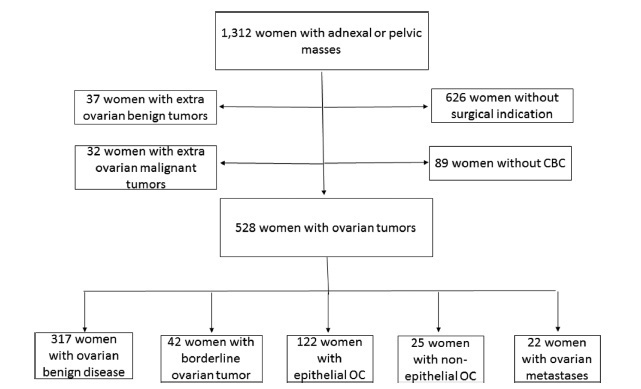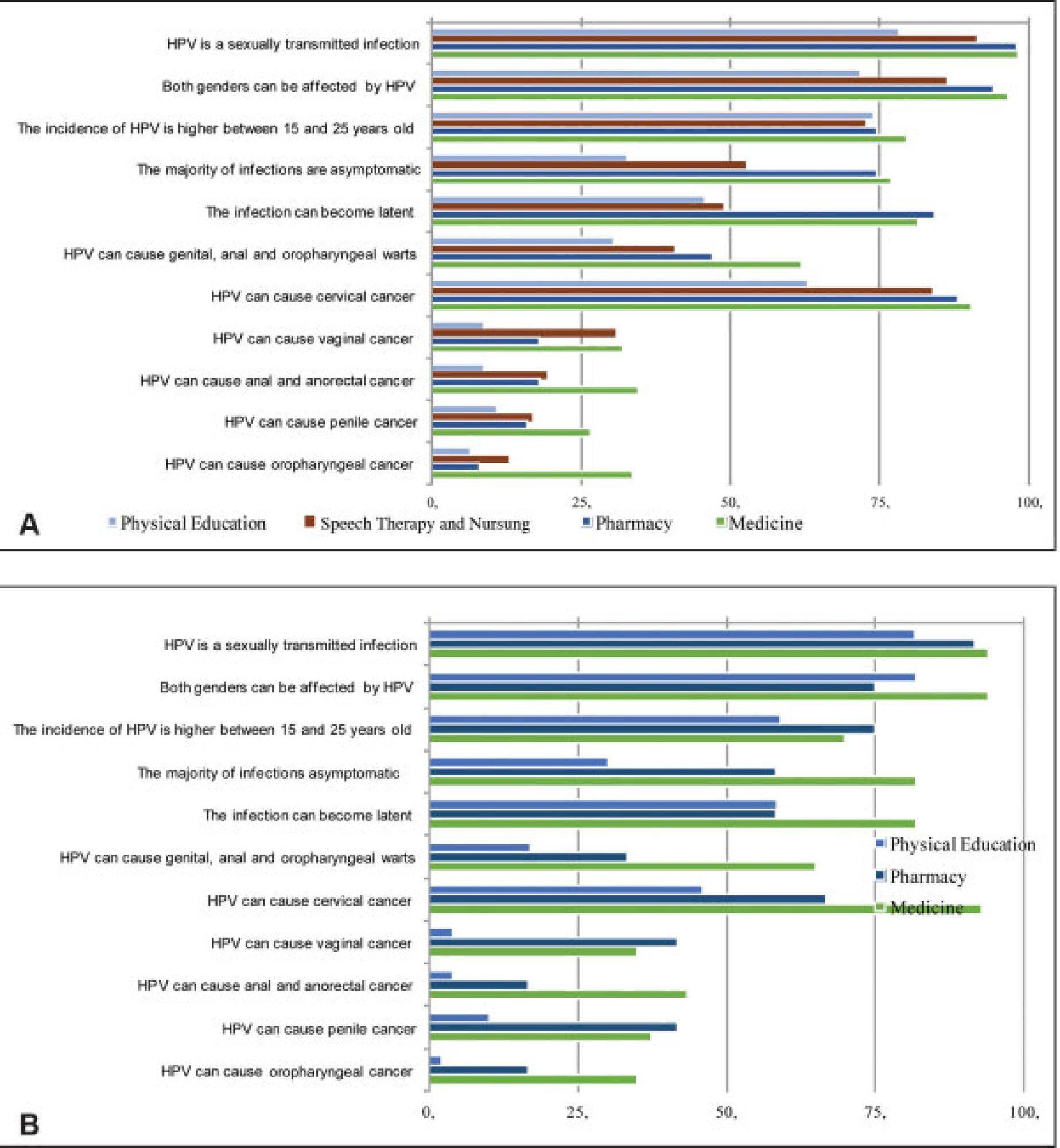You searched for:"Luís Otávio Sarian"
We found (15) results for your search.Summary
Rev Bras Ginecol Obstet. 2020;42(7):397-403
To evaluate the diagnostic accuracy of cancer antigen 125 (CA125) and complete blood count (CBC) parameters, such as the neutrophil to lymphocyte ratio (NLR), the platelet to lymphocyte ratio (PLR), and thrombocytosis in patients with ovarian masses.
The present is a retrospective study conducted at a single tertiary hospital from January 2010 to November 2016. We included consecutive women referred due to suspicious adnexal masses. The CBC and CA125 were measured in the serum of 528 women with ovarian masses before surgery or biopsy. We evaluated the diagnostic performance of the NLR, PLR, platelets (PLTs), CA125, and the associations between them. We tested the clinical utility of the CBC parameters and CA125 in the discrimination of ovarian masses through decision curve analysis (DCA).
The best balance between sensitivity and specificity was obtained by the associations of CA125 or PLTs ≥ 350/nL, with 70.14% and 71.66%, CA125 or PLTs ≥ 400/ nL, with 67.30% and 81.79%, CA125 or PLR, with 76.3% and 64.87%, and CA125 or NLR, with 71.09% and 73.89% respectively. In the DCA, no isolated CBC parameter presented a higher clinical utility than CA125 alone.
We showed that no CBC parameter was superior to CA125 in the prediction of the malignancy of ovarian tumors in the preoperative scenario.

Summary
Rev Bras Ginecol Obstet. 2004;26(6):457-462
DOI 10.1590/S0100-72032004000600006
OBJECTIVE: to assess the ability of Pap smear and hybrid capture II (HCII) to detect clinically significant cervical lesions (CIN2/3) in women referred to hospital due to atypical squamous cells of unknown significance (ASCUS) or low-grade squamous intraepithelial lesions (LSIL). METHODS: a cross-sectional study comprising 161 women referred to the Taubaté University Hospital due to ASCUS/LSIL, between August 2000 and September 2002. All women responded to a questionnaire regarding sociodemographic and reproductive characteristics and were subjected to gynecological examination with specimen collection for Pap test and HCII, along with colposcopy and eventual cervical biopsy. The relationship between HCII results and age, use of condom, oral hormonal contraception, and smoking were evaluated by the chi-square test. The sensitivity, specificity, positive and negative predictive values of both Pap test and HCII were calculated. All calculations were performed within 95% confidence intervals. RESULTS: sixty-seven percent of the women that tested positive for HPV were less than 30 years old. Pap smear and HCII showed the same 82% sensitivity in detecting CIN2/3 when the threshold for a positive Pap result was ASCUS, LSIL or HSIL. Pap smear specificity and positive predictive values were substantially increased when only HSIL results were considered as positive (from 29 to 95% and 12 to 50%, respectively). These figures were superior to those of HCII, but at the expense of an expressive loss of sensitivity (from 82% to 41%). CONCLUSIONS: our results substantiate the potential of HCII in detecting CIN2/3 among women referred due to ASCUS/LSIL.
Summary
Rev Bras Ginecol Obstet. 2012;34(11):511-517
DOI 10.1590/S0100-72032012001100006
PURPOSE: To assess the association between clinical symptoms and the diagnosis of malignancy in women with adnexal tumors who underwent surgery. METHODS: Cross-sectional study, in which 105 women with adnexal tumors and indication for laparotomy/laparoscopy were included. All women were treated at a teaching hospital in the state of São Paulo between November 2009 and March 2011. All patients underwent a structured interview about the occurrence of 18 symptoms associated with ovarian cancer. The interview included the severity, frequency, and duration of these symptoms in the 12 months prior to the first medical consultation. The CA125 levels and the ultrasound classification of the tumors were also evaluated. We calculated for each symptom the prevalence ratio with 95% confidence intervals. The golden-standard was the result of the pathological examination of the surgical specimens. RESULTS: Of the 105 women included, 75 (71.4%) had benign tumors and 30 (28.6%) had malignant ones. In women with malignant tumors, the most frequent symptoms were: abdominal bloating (70%), increased abdominal size (67%), pelvic pain (60%), menstrual irregularity (60%), swelling (53%), abdominal pain (50%), backache (50%), and early repletion (50%). Women with benign tumors showed essentially pelvic pain (61%), menstrual irregularities (61%), and abdominal swelling (47%). Symptoms significantly associated with malignancy were: bloating (PR=2.0; 95%CI 1.01 - 3.94), increased abdominal size (PR=2.16; 95%CI 1.12 - 4.16), backache (RP=1.97; 95%CI 1.09 - 3.55), swelling (PR=2.25; 95%CI 1.25 - 4.07), early repletion (RP=2.06; 95%CI 1.14 - 3.70), abdominal mass (PR=1.83; 95%CI 1.01 - 3.30), eating difficulties (PR=1.98; 95%CI 1.10 - 3.56), and postmenopausal bleeding (PR=2.91; 95%CI 1.55 - 5.44). The presence of pelvic pain, constipation, dyspareunia, fatigue, abdominal pain, nausea or vomiting, menstrual irregularity, weight loss, diarrhea, and bleeding after intercourse was similar in both groups. CONCLUSIONS: In women with adnexal tumors including indication of surgical treatment, the preoperative evaluation of symptoms may help predicting malignancy.
Summary
Rev Bras Ginecol Obstet. 2020;42(9):555-561
To evaluate the role of clinical features and preoperativemeasurement of cancer antigen 125 (CA125), human epididymis protein(HE4), and carcinoembryonic antigen (CEA) serum levels in women with benign and malignant non-epithelial ovarian tumors.
One hundred and nineteen consecutive women with germ cell, sex cordstromal, and ovarian leiomyomas were included in this study. The preoperative levels of biomarkers were measured, and then surgery and histopathological analysis were performed. Information about the treatment and disease recurrence were obtained from the medical files of patients.
Our sample included 71 women with germ cell tumors (64 benign and 7 malignant), 46 with sex cord-stromal tumors (32 benign and 14 malignant), and 2 with ovarian leiomyomas. Among benign germ cell tumors, 63 were mature teratomas, and, amongmalignant, fourwere immatureteratomas. Themost common tumors in the sex cordstromal group were fibromas (benign) and granulosa cell tumor (malignant). The biomarker serum levels were not different among benign andmalignant non-epithelial ovarian tumors. Fertility-sparing surgeries were performed in 5 (71.4%) women with malignant germ cell tumor. Eleven (78.6%) patients with malignant sex cord-stromal tumors were treated with fertility-sparing surgeries. Five women (71.4%) with germ cell tumors and only 1 (7.1%) with sex cord-stromal tumor were treated with chemotherapy. One woman with germ cell tumor recurred and died of the disease and one woman with sex cord-stromal tumor recurred.
Non-epithelial ovarian tumors were benign in the majority of cases, and the malignant caseswere diagnosed at initial stages with good prognosis. Themeasurements of CA125, HE4, and CEA serum levels were not useful in the preoperative diagnosis of these tumors.
Summary
Rev Bras Ginecol Obstet. 2010;32(12):602-608
DOI 10.1590/S0100-72032010001200007
PURPOSE: to prospectively evaluate the effects of immediate breast reconstruction on the quality of life of women who underwent mastectomy. METHODS: 76 women that underwent mastectomy at Centro de Atenção Integral à Saúde da Mulher da Universidade Estadual de Campinas, in Campinas, São Paulo, Brazil, from August 2007 to December 2008, were included. Two groups were formed: 41 women who underwent mastectomy combined with immediate breast reconstruction (M+RI) and 35 that were subjected to mastectomy alone (M). The quality of life evaluation was assessed with the World Health Organization's questionnaire - Quality of Life (WHOQOL-100). The questionnaire was administered on three occasions: at the time of admission, one month after surgery, and again six months after surgery. The WHOQOL-100 scores were calculated according to analysis' guidelines by the World Health Organization. For comparison of the scores between groups, it was used the Student's t-test, Fisher exact test, chi-square test, and Mann-Whitney test. For the analysis of repeated measures over time, ANOVA and ANOVA for repeated measures were used. RESULTS: at all time points evaluated, beginning with the preoperative assessment, the average quality of life scores of the M+IR Group were higher than those of the M Group, primarily in the "physical", "psychological", "level of independence" and "social relationships" domains of the questionnaire. Of the six areas covered by the questionnaire, three ("physical", "social relations", "environment") showed no significant differences between groups. The M+IR Group had a better score (15.5 to 14.9 for the M+IR and 14.3 to 14.2 for M; p=0.04) in the psychological domain. There was a significant reduction in the level of independence in the first month after surgery in both groups, with a significant recovery after six months. CONCLUSIONS: the present results suggest that immediate breast reconstruction is significantly beneficial regarding the psychological aspects of quality of life, without affecting the patient's physical functionality.
Summary
Rev Bras Ginecol Obstet. 2005;27(12):737-743
DOI 10.1590/S0100-72032005001200006
PURPOSE: to evaluate the frequency of anxiety and depression in main caretakers of patients with terminal breast or gynecological cancer. METHODS: for this cross-sectional study, 133 informal caretakers of terminally-ill breast and gynecologic cancer patients were included. Patients were hospitalized for palliative care in the Oncology Clinic of the "Centro de Atenção Integral à Saúde da Mulher (Campinas, Brasil) from August 2002 to May 2004. Seventy-one of the patients had breast cancer and 62 had gynecological malignancies. Hospital Anxiety and Depression Scale (HAD) was applied to these informal caretakers, in order to detect anxiety and depression, and they were also interviewed to provide additional information regarding their age, gender, religion, relation to patient, current occupation, if they cared for other people, whether their routine had changed and whether other people helped them to care for the patient. Logistic regression was used to calculate the odds ratio (OR) and its confidence interval (CI), used to assess the relationship between the diagnoses of anxiety and depression among the informal caretakers. For multiple analyses, the stepwise criterion for variable selection was used. RESULTS: 43% percent of the patients identified their daughters as their main caretaker, and 24%, their husbands. Most of the caretakers were over 35 years old (63%), 68% were female, 59% were unemployed, 47% cared for another person and 84% referred that his/her routine had changed because of caring. Anxiety was detected in 99 caretakers (74.4%) and depression in 71 (53.4%). Anxiety and depression were strongly correlated (odds ratio 5.6; 95% confidence interval 2.2 to 15.9). Bivariate analysis disclosed that the patients' husbands were less affected by depression, but multivariate analysis revealed that only the fact of being male was related to a lower prevalence of anxiety. CONCLUSION: caring for terminally-ill cancer patients led to high prevalence of anxiety and depression. Only men and the patients' husbands were found to have a lower prevalence of anxiety.
Summary
Rev Bras Ginecol Obstet. 2020;42(2):96-105
To evaluate the knowledge related to human papillomavirus (HPV) infection and the rate of HPV vaccination among undergraduate freshmen and senior students of medicine, pharmacy, speech therapy, nursing and physical education in a Brazilian university.
A questionnaire concerning sociodemographic aspects, sexual background, and knowledge about HPV and its vaccine was filled out by 492 students. Three months later, a second questionnaire, concerning the new rate of vaccination, was applied to 233 students.
Among the 290 women who answered the first questionnaire, 47% of the freshmen and 13% of the seniors stated they were not sexually active, as well as 11% of the 202 freshman and senior male students. Although the knowledge about HPV was higher among women, they reported a lower use of condoms. More than 83% of the women and 66% of the men knew that HPV can cause cervical cancer, but less than 30% of the students knew that HPV can cause vulvar, anal, penile and oropharyngeal cancer. Less than half of the students knew that HPV causes genital, anal and oropharyngeal warts. Comparing the students, the seniors had more knowledge of the fact that HPV is sexually transmitted, and that HPV infection can be asymptomatic. The rate of vaccination was of 26% for women, and of 8% for men, and it increased to 52% and 27% respectively among the 233 students evaluated in the second questionnaire.
As almost half of freshman women declared being sexually inactive, the investment in public health information programs and easier access to the HPV vaccine seem to be a useful strategy for undergraduate students.
